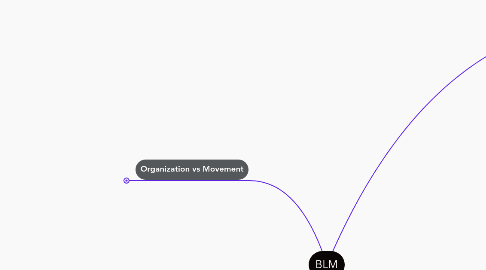
1. Organization vs Movement
1.1. Organization
1.1.1. Started in 2013 in response to the acquittal of the murderer of Trayvon Martin
1.1.2. Founders: Alicia Garza, Opal Tometi, Patrisse Cullors
1.1.3. Often criticized in the media for being Marxist
1.1.3.1. Cullors has referred to herself and Garza as trained Marxists.
1.1.3.2. Foundation of Economic Education
1.1.3.2.1. published in 2015, contained a specific call to “[disrupt] the Western-prescribed nuclear family structure.”
1.1.3.3. As of January 2021 there is no reference to Marxism
1.1.4. Black Lives Matter About Page
1.2. Movement
1.2.1. Black Lives Matter is not exclusive to the organization (duh). You can be Pro-Black Lives (movement) without being Pro-Black Lives Matter (org).
1.2.1.1. Example: I'm against fascism, but I'm not part of "Antifa." I love animals, but I don't work for PETA. Simple.
1.2.1.2. Republican Senator Romney, a known Conservative, marched with the Black Lives Matter protest knowing that it is about the people and not any one organization.
1.2.2. Out of the over 10,000 protests that have occurred in the US, 93% have been peaceful, thus debunking the association off a violent riot with BLM protests. Just for funsies, the "Stop the Steal" protests equaled 452 yet was 80% peaceful. Meaning, "Stop the Steal" related protests had higher likelihood to become violent than that of a BLM protest.
2. Defund the Police
2.1. It's not abolition it's reform
2.2. Nature Article
2.2.1. Arrests every 3 sec and less than 5% are serious violent crimes
2.2.2. Survey of 47 of the largest US Law Enforcement agencies
2.2.2.1. Data Collection in itself can reduce gun death. *By requiring Officers to file a report when they point their gun was associated with reduced gun death.
2.2.2.1.1. 39% changed their use of force
2.2.2.1.2. Officer involved shootings dropped by 21%
2.2.3. Disciplinary action is difficult. *Union contracts give officers protection that have been tied to increase in misconduct.
2.2.3.1. We monitor performance of doctors, so why don't we do the same for officers?
2.2.3.2. Officers that were fired for misconduct are often rehired
2.2.3.2.1. Florida agency showed that about 3% of that state's police force had been fired or resigned in lieu of being dismissed
2.2.3.2.2. These officers tended to move to smaller agencies which served a slightly larger proportion of Black residents
2.2.4. 1,000 civilians are killed each year by Police
2.2.4.1. Black men are 2.5x more likely than white men to be killed. *Those fatally shot by police are 2x likely as white people to be unarmed!
2.2.4.2. We don't have a lot of data about police shootings because Law Enforcement agencies give data VOLUNTARILY. We only have data from 40% of the Law Enforcement agencies.
2.2.4.3. Based on 2 million calls made, 911 dispatched to predominantly Black neighborhoods
2.2.4.3.1. White officers fired their gun 5x more as Black officers
2.3. Five Thirty Eight Article
2.3.1. The statistics that we have now do not encompass the full extent of racial bias. Meaning it's far worse than what is reported.
3. Systemic Racism
3.1. Center for American Progress
3.1.1. Wealth
3.1.1.1. For Black people, the American experience began with slavery, which allowed whites to profit off of the bodies and blood of enslaved people
3.1.1.2. The Black-White wealth gap is a product of intentional systematic policy choices. The only way to correct this wrong is to make intentional systematic changes in response.
3.1.1.3. Hispanic families have only slightly more wealth than Black families. In 2016, the median wealth for Black and Hispanic families was $17,600 and $20,700, respectively, compared with White families’ median wealth of $171,000
3.1.1.4. Black families have a fraction of the wealth of White families
3.1.1.5. The median wealth for Black households with a college degree equaled about 70 percent of the median wealth for White households without a college degree. The gap worsens as households grow older.
3.1.2. Health
3.1.2.1. Centers for Disease Control and Prevention, for example, Black mothers and children die at disproportionately higher rates than their White counterparts, regardless of their income levels.
3.1.2.2. Researchers have suggested that racism—which has produced segregated neighborhoods with fewer hospitals, higher rates of chronic illnesses, and unequal access to health care—is the main culprit.
3.1.3. Employment
3.1.3.1. In 1979, Black men earned 22% less than White men; by 2015, Black men earned 31% less.
3.1.3.2. University of Michigan Institute for Social Research found that White applicants receive 36% more callbacks than Black applicants with similar qualifications.
3.1.3.3. Disparities in employment may actually be underestimated because they do not account for the large number of Black people who have been negatively impacted by a criminal justice system that has aggressively and persistently targeted communities of color.
3.2. Racism is a Public Health Crisis
3.2.1. Structural racism
3.2.1.1. Key areas (education, employment, healthcare, housing, and law enforcement) are structured to advantage the group in power
3.2.2. Institutional racism
3.2.2.1. Operates through institutions’ “neutral” practices and policies that establish separate and independent
3.2.3. Interpersonal racism
3.2.3.1. Operates through individual interactions, where an individual’s conscious (explicit) and/or unconscious (implicit) racial prejudice restricts equal access to the key areas of the SDOH.
3.2.4. Intrapersonal or internalized racism
3.2.4.1. is when racial and ethnic minorities accept stereotypes about themselves and those who share the same racial identities, while believing that members of other racial groups are superior, which can be harmful to the psychological wellbeing and physical health of racial and ethnic minorities.
